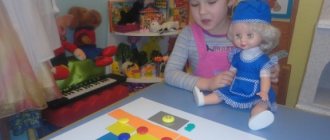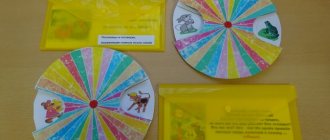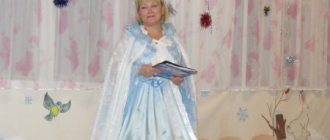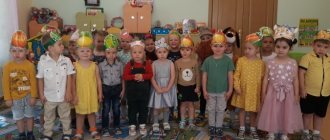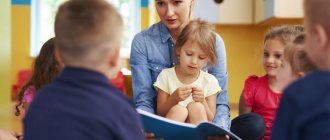Using the modeling method in teaching preschool children
Using the Simulation Method
in teaching preschool children
In modern conditions of rapidly changing life, a child is required not only to possess knowledge, but also, first of all, to be able to obtain this knowledge himself and operate with it. One of the main tasks of modern pedagogy is the search for opportunities to use the hidden reserves of children’s mental activity, the search for ways of effective learning. One of these ways that intensively develops children's cognition can be modeling.
A preschooler is deprived of the opportunity to write down, make a table, or note anything in writing. In kindergarten, only one type of memory is mainly involved - verbal. Modeling is an attempt to use visual, motor, and associative memory to solve cognitive problems. The accessibility of this method for preschoolers is determined by the fact that modeling is based on the principle of substitution - a real object can be replaced in children’s activities by another sign, object, or image.
The relevance of using visual modeling in working with children is that:
- the use of visual modeling arouses children’s interest;
— facilitates and accelerates the process of memorizing and assimilation of material, forms techniques for working with memory;
— using modeling, we teach children to see the main thing, to systematize the acquired knowledge.
Modeling -
visual and practical teaching method. The modeling method was first developed by teachers and psychologists. It lies in the fact that a child’s thinking is developed with the help of special schemes, models, which reproduce the hidden properties and connections of a particular object in a visual and accessible form.
Many preschool teaching methods are based on the use of visual models, for example, the method of teaching preschoolers to read and write (L. E. Zhurova) involves the construction and use of a visual model of the sound composition of a word. Issues of using visual modeling to form ideas about the work of adults have been developed (,). Great importance is attached to the use of graphic modeling in productive activities of children (,), in design (). Models can be used when children perform physical exercises (for this, the movements are encrypted in the drawing, the teacher just needs to show the card, and the children begin to perform the exercise depicted on the model). In general, the modeling method, with sufficient study, can be successfully applied in all educational areas of preschool education.
Today we will dwell in more detail on the use of visual modeling in the formation of coherent speech in preschool children
Models are divided into three groups
1. Subject.
They help reproduce the structure and features, internal and external relationships of real objects and phenomena. These are different objects and designs (model of an aquarium, Earth, natural zones “North”, “Forest”)
2. Subject-schematic models
. Here, the essential components identified in the object of cognition and the connections between them are indicated using substitute objects and graphic signs. An example of a simple subject-schematic model can be a model for revealing the concept of protective coloring, as a manifestation of the connection of an animal with its environment (a sheet of cardboard of a certain color and the figure of an animal: if their colors match, then the animal is not visible).
3. Graphic models
. They convey generally (conditionally) the characteristics, connections and relationships of phenomena. An example of such a model would be a weather calendar kept by children using special symbols to indicate phenomena in inanimate and animate nature.
One of the types of graphic models is mnemonics.
Mnemonics in preschool pedagogy are called differently: this technique is called
sensory-graphic diagrams
, -
subject-schematic models
, N -
a scheme for composing a story,
mnemonics is also called
symbolic analogy, graphic analogy, pictograms
Mnemonics
- a system of various techniques that facilitate memorization and increase the memory capacity of children by forming additional associations, organizing the educational process in the form of a game. The use of mnemonics is currently becoming relevant. The main “secret” of mnemonics is very simple and well known. When a person connects several visual images in his imagination, the brain records this relationship. And later, when recalling one of the images of this association, the brain reproduces all previously connected images. Mnemonics is a set of rules and techniques that facilitate the process of memorizing information.
Reliance on a visual image is very important and mandatory, since if, when reproducing the text, this visual image does not appear in the imagination, then the child does not understand this text. Thus, the technique of symbolization is the shortest way to forming the process of memorization and accurate transmission of information that requires verbatim repetition, for example in poetry. For this, a schematic representation of the individual parts is sufficient, which will facilitate memorization and subsequent reproduction of the entire image in rhymed form.
The models are multifunctional. They can be used in direct educational, joint and independent activities.
I will briefly touch on the methods of teaching children graphic models or graphic analogy
Using a graphic analogy, we teach children to see the most important thing (as if using the folding technique). Where to start?
Start with the simplest thing, play the game “What’s in the circle?” with your children. In this game, children become familiar with the symbols of any objects, learn to classify, and develop communicative activity.
Draw, for example, circles on a sheet of paper; these can be triangles, squares - any geometric figure and at the same time list: “This is an apple, this is a pear, this is a plum,” etc. Usually children understand what objects you are listing and help name the missing ones. Then draw a big circle around it and ask: “What did you list? (Fruits)? Then what is a circle? Next, give the children the opportunity to list all the options: a circle is a garden, a basket, a vase, a plate, a store, a market, a dish, a still life... When the children’s answers run out, say: “No, this is not fruit, this is...” - you can list several options names of pieces of furniture. Then the big circle will be an apartment, a warehouse, a store, a kindergarten, etc. Or - in a circle there are vegetables, birds, flowers, trees, toys, even the children themselves - there is a lot of room for work. The main goal of the game is to show children that an object can be designated by a geometric figure.
Then you can go further - propose to designate objects not by any shape, but by one that in appearance resembles the above. For example, vegetables, fruits - in a circle; furniture, houses - rectangle; person - a triangle. This will strengthen your children’s ability to see an abstract image of an object.
When children learn to depict surrounding objects and heroes of works with symbols, you can offer to create a model of a fairy tale. It is necessary to create symbol cards together with the children. It is most convenient to do this in special moments. We must remember that the number of lines in a symbolic analogy should be minimal. In younger groups, when children are just being introduced to symbolization, the teacher can offer them cards to choose from. Discuss and play with these images with the kids so that the children can see for themselves and convince us which card means what. Show a card with a picture of a circle and ask, “What does it look like?” The answers will be different: ball, circle, wheel..., sun. “Let’s make sure the sun shines.” The kids will definitely say that there are not enough rays. So a new symbol was born.
Starting from the middle group, when the children already have broader concepts about the world around them, they themselves are involved in drawing up symbol cards. Each child independently comes up with his own symbol, explains why he drew it this way and not otherwise, then during the discussion the most suitable one is chosen.
It is very convenient to use the technique of empathy. For example, with the help of the teacher’s leading questions, the child takes on the role of a dog that barks furiously, falling on its front paws, or the role of a disheveled kitten whose fur is raised upward.
When compiling cards-symbols denoting actions, signs of objects, states (fun, plaintive, scared, etc.) for a more complete understanding, it is necessary to play with the children, reproduce the action at the emotional-gestural level
When there are many words in the text that belong to one part of speech, the teacher can play with the children this way: put out a number of cards with symbols, and the children choose the one they need based on the text from the many offered.
It is important to remember that the use of graphic analogy requires taking into account the age characteristics of children
Today, teachers of Preschool Educational Institution No. 21 will share their experience of working with visual and graphic models, which are used to enrich vocabulary, form grammatical structure of speech, develop coherent speech, and tell you about the use of models when solving riddles and memorizing poetry
Under the pines, under the fir trees, there is a bag of needles.
Round, but not a ball, yellow, but not a pumpkin, with a tail, but not a mouse
In the clearing, by the path, there are red peas. Whoever passes by puts it in his mouth
The main feature of the riddle is that it is a verbal-logical task. To guess a riddle means to answer a question, that is, to perform a complex logical operation
Observations of children show that guessing occurs in the most intelligent preschoolers, as if by itself or by enumerating options. At the same time, most of the children in the group are passive observers. The teacher acts as an expert. The correct answer of a gifted child to a specific riddle is very quickly remembered by other children. If the teacher asks the same riddle after some time, then most of the children in the group simply remember the answer. When developing a child’s mental abilities, it is more important to teach him to compose his own riddles than to simply guess familiar ones.
By asking riddles, you teach your child to reason, draw conclusions and prove his point of view.
There are several models for composing riddles. I'll introduce you to some of them
| Which? | What happens the same? |
To create a riddle, an object (the sun) is selected. Next, the children give figurative characteristics according to the characteristics specified by the teacher.
After filling out the tablet, the teacher offers to read the riddle, inserting the connectives “How” or “But not” between the lines of the right and left columns. Orange, but not an orange, round, but not a ball, luminous, but not a light bulb
What color is the sun? (Orange) What happens the same? (Orange)
What is its shape? (Round) What happens the same? (Ball)
What kind of sunshine is it in terms of actions? (luminous). What happens the same? (Bulb)
“What does it look like? What is the difference?"
The peculiarity of mastering this model is that the child, comparing one object with some other object, finds common and different between them.
Protocol for composing a riddle about a mushroom:
-What does a mushroom look like? - For a peasant.
- How is it different from a peasant? — The mushroom has no beard.
-What else does it look like? - To a house, but without windows.
- And what else? — Like an umbrella, but the umbrella has a thin handle.
The text of the resulting riddle: “Looks like a peasant, but without a beard; looks like a house, but without windows; like an umbrella, but with a thick stem.”
Mnemonic tables are especially effective when learning poems. The bottom line is that for every word or small phrase a picture (graphic image) is created; Thus, the entire poem is sketched schematically. After this, the child reproduces the entire poem from memory, using a graphic image. At the initial stage, the adult offers a ready-made plan - a diagram, and as the child learns, he is also actively involved in the process of creating his own diagram. Mastering the techniques of working with mnemonic tables significantly reduces training time and at the same time solves problems aimed at: developing basic mental processes - memory, attention, imaginative thinking; development of fine motor skills of the hands with partial or complete graphic reproduction of the text. Mnemonics helps develop: associative thinking, visual and auditory memory, visual and auditory attention, imagination. Using supporting drawings to teach memorizing poems captivates children and turns the activity into a game. The visual image that the child retains after listening, accompanied by viewing the drawings, allows him to remember the text much faster.
To learn each poem, you need to develop your own mnemonic table, select pictures for the selected poem (preferably for each line). And so, step by step, a mnemonic table is created.
The next stage of working with the mnemonic table is an emotional, expressive reproduction of the text of the poem. Then vocabulary work is carried out on the work, a conversation is held on the meaning of what was read, and children are given the opportunity to reproduce the text based on the drawings
Practice shows that gradually the memory of preschoolers is strengthened, their imaginative thinking develops, they remember texts much better, larger in volume, easier and more emotional. With this method of working, the entire poem is remembered. Learning has become a fun, emotional activity for preschoolers, and at the same time the content of the text is tangible, visible, imaginable.
Get text
Teacher portal
Author:
Ekaterina Andreevna Pushina
Position:
teacher
Educational institution:
MBDOU No. 1 “Cheburashka”
Settlement:
Ust-Ilimsk, Irkutsk region
Name of material:
Article
Topic:
“Visual modeling technology in practice in preschool educational institutions”
Date of publication:
03/16/2016
Section :
preschool education
Topic: “Visual modeling technology in practice in preschool educational institutions”
Relevance:
In our dynamic age, the flow of information has increased significantly.
Accordingly, the process of perceiving this information has become more complicated. Leading specialists in preschool education N.N. Podyakova rightly emphasized that at the present stage it is necessary to give children the key to understanding reality, and not strive for exhaustive information. In preschool pedagogy, a model can become a tool of cognition. Preschoolers are deprived of the opportunity to record information or note anything in writing in class, so in kindergarten mainly one type of memory is involved - verbal. Modeling
is an attempt to use visual, motor and associative memory to solve cognitive problems. This is an optimal and effective technology that allows you to maximize speech activity while maintaining interest in the lesson.
The accessibility of modeling to preschoolers was also noted in the studies of L.A. Wenger, D.B. Elkonina. Modeling is based on the principle of substitution, where real objects are replaced by a drawing, diagram, or icon. Therefore, the relevance is that:
1-preschooler is flexible, easy to teach, but quickly gets tired and loses interest.
Modeling arouses interest and thereby solves this problem. 2- The use of analogy symbols facilitates and speeds up the memorization process. But one of the rules of memorization says: “When you learn, write down, draw, damn it!” 3-Graphic analogies help to see the main thing and systematize the acquired knowledge. Thus, modeling is a visual, practical teaching method developed by D.B. Elkonin, N.N. Podyakova, N.A. Vetlugina. It lies in the fact that the child’s thinking develops with the help of special schemes, models, which in a visual and accessible form reproduce the hidden properties and connections of a particular object. The formation of visual modeling skills occurs with a constant increase in the share of children’s independent participation in the work process. This technology has variability, flexibility, and versatility, since the conventions are easily perceived by children. Pictograms and diagrams used in the work. Mnemonic tables, icons-symbols, stylized pictures, graphs, plans not only activate children. But they also contribute to the transfer of speech skills from the “zone of proximal development” to the “zone of actual development.” At preschool age, various types of models are used:
object models - in which design features, proportions, and the relationship of parts of any objects are reproduced.
These can be models of buildings, a globe, an ecosystem. Subject-schematic models - they contain features, connections, relationships, presented in the form of model objects. Examples include algorithms, sequences of actions (washing, serving, caring for plants. Cooking technologies, logorhythmic exercises) Graphic models (graphs, diagrams) convey conditionally generalized features, connections, relationships. Phenomena. An example would be the “Weather and Nature Calendar”, a plan for a group, a site, a doll’s corner, or a travel route. During visual modeling, children are introduced to a graphical method of transmitting information - a model. Geometric figures, symbolic images, plans can act as conditional substitutes (elements of the model). By obtaining information using the method of visual modeling, children learn:
to explore, compare, draw up an internal plan of mental actions, and improve speech functions.
- Form and express judgments and conclusions. The use of visual modeling has a positive impact on the development of not only speech processes, but also non-speech ones: attention, memory, thinking. Visual modeling technologies require compliance with the following teaching principles: developmental and educational nature of training; - systematicity and consistency; - consciousness and independence; - creative activity; - visibility and accessibility; - a combination of collective and individual work. The formation of visual modeling skills occurs in the following stages: - assimilation and analysis of sensory material; translation into sign-symbolic language; - work with the model. The stages of developing visual modeling skills solve the following
problems:
1. Familiarity with the graphical method of providing information.
2. Formation of the skill of decoding the model. H. Formation of independent modeling skills. At school, the sign-symbolic system is constantly used. With its help, children are taught to encode the information being studied. This is a necessary component of learning, and correct speech is one of the indicators of a child’s readiness for school, the key to successful literacy and reading. Our introduction of visual modeling into the learning process in our group allowed us to purposefully develop speech, enrich the vocabulary, consolidate new word formation, form and improve the ability to use various sentence structures in speech, describe objects, and compose stories. Retelling, correct use of prepositions. At the initial stages of our work on introducing visual modeling, we used the following material: pictures, objects, stylized images that provide support for visual-figurative thinking, which corresponded to the initial stage of learning - mental operations: synthesis, analysis, classification. At the next stage, more complex operations were used - generalization, abstractions, where visual models were based on both figurative and verbal-logical thinking, that is, a speech pattern. Methods of visual modeling in our group include:
designating objects using a variety of substitutes;
use and creation of different types of conditional diagrams, images of real objects and objects; ability to read and create graphic images of signs. Objects belonging to one or another class (clothing, shoes, fruits, vegetables, etc.) the ability to navigate in space according to a diagram; the ability to draw up a plan of real space (room, group, area.) the ability to use space-time models when retelling, composing a story; independent creation of models according to your own plans. Thus, visual modeling is used in all types of children's activities and in all educational areas, because it is a source of development of mental abilities and creativity in preschool childhood. At this age, the development of imagination and imaginative thinking is the main direction of mental development. We mostly use modeling in classes on teaching coherent speech, literacy, cognition, artistic activity, labor, experimental activities, independent, gaming, music, physical education, but of course taking into account age characteristics. Stages of introducing visual modeling into practice:
Stage 1 - teach how to read tables: a.
providing information on a topic in the form of an educational conversation; b. viewing the finished table. Compiled according to the content of the topic, decoding of symbols, decoding of information; V. retelling information by children based on a diagram with and without the help of an adult; d. graphic sketches of diagrams, mnemonic tables based on the results of activities. Stage 2: introduce general models of encoding information about objects, objects, and phenomena. a.topic message; b. consideration of the general encoding scheme (the material for this is any generalizing concept: animals, sense organs, transport, trees, etc.) c. drawing up a model of information about a specific topic based on a general scheme. Modeling is carried out under the guidance of an adult using guiding questions. What does this sign mean? What can we tell you about this object? How do we represent this in our model? Guessing riddles - mnemonic tables compiled by the teacher based on the general scheme. Stage 3: joint coding of information, discussion of variants of signs reflecting one or another property of the item being coded, and independent creation of tables based on the material covered. Stage 4: practicing coding skills in different types of activities. With the help of a pictorial and graphic plan, presented in the form of pictograms and object pictures, children retell texts, learn riddles, compose stories, sketch the texts of riddles, quatrains, and short stories. A set of pictograms allows you to show the diversity of words with the same root, and the drawing shows the direction of thoughts. The most positive thing about using pictograms is that the teacher’s speech is reduced to a minimum. Pictograms can be changed and supplemented. It all depends on the creativity of the teacher. At the initial stage of learning to compose descriptive stories, we made a diagram from individual cards, substituting them one by one for the object being described, and then gradually moving them away from each other and finally combining them into a single cell diagram (mnemonic table.) The use of mnemonic tables has a positive effect:
1 Visual thinking develops powerfully; 2. stable attention and long-term concentration are developed; 3. the ability for effective independent learning is formed. Thus, with the help of visual modeling, the following results can be achieved: 1. there will be an interest in memorizing poetry, logorhythmic exercises, finger gymnastics; 2. vocabulary will increase; Z. children will overcome shyness, timidity, and the acquired skill will help them to hold themselves freely and speak out in front of an audience. An increased sense of interest, satisfaction with their answers, the results of their work improve the child’s psychological processes: memory, attention, thinking, speech, which has a positive effect on the results of correctional education. work.
